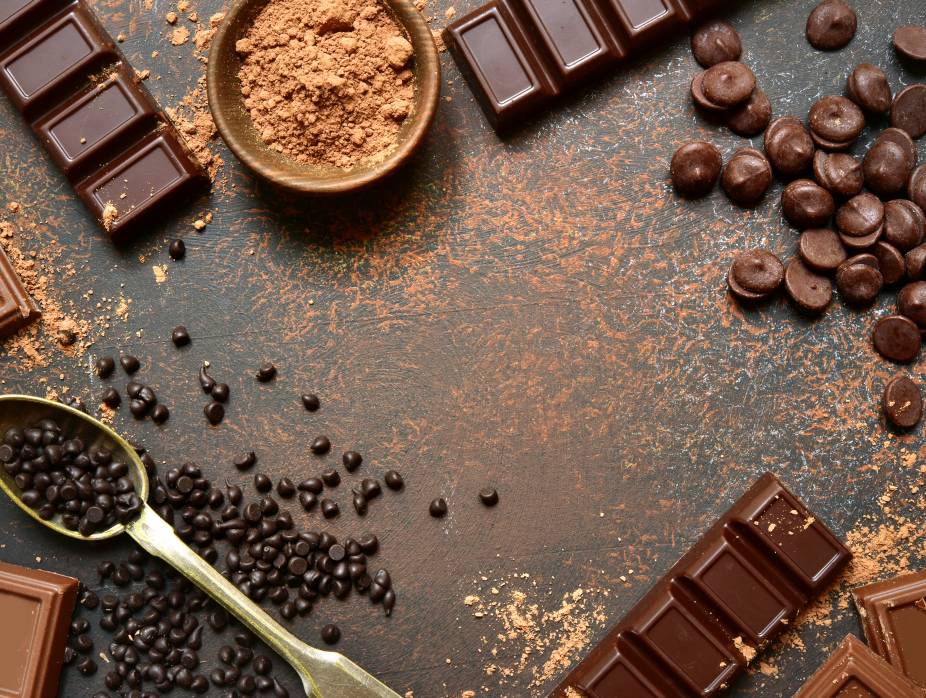Most of us consider chocolate a sweet "sin" that we should avoid. And yet, chocolate can prove beneficial to our health and especially to our mood.
When we talk about chocolate, we mean all the derivatives of cocoa butter that are transformed into sweets or beverages.
The bad thing about chocolate-based confectionery products is that they contain a lot of sugar and other harmful substances such as flavoring agents, preservatives, etc.
To make it clear: Chocolate alone is not harmful. On the contrary, it contains several nutrients, has antioxidant activity and gives energy. Of course, as with anything, we should avoid abuse.

History of chocolate
The Aztecs were the first to use cocoa beans to make chocolate. In fact, they attributed almost divine attributes to the cocoa tree. It is no coincidence that the cocoa tree was named in Latin "Theobroma", that is, "food of the gods".
After crushing the cocoa beans and making them powder, the Aztecs made a drink called "Choclatl".
Other spices were added to this drink and they were hot. They considered it to be a medicine that cured any illness. It also had digestive action.
The Spaniards were the first to bring cocoa to Europe, and many years later solid chocolate was created.
It can regulate mood
Chocolate contains all the nutrients, ie proteins, carbohydrates and fats.
It is a natural source of minerals and trace elements such as calcium, phosphorus, magnesium, iron, zinc and copper. In addition, it contains significant amounts of Vitamin A and E.
Chocolate, which is high in cocoa, is rich in polyphenols, which have antioxidant activity.
Perhaps the most characteristic property of chocolate is that it can regulate mood by increasing serotonin and endorphin levels. By chance, endorphins and serotonin are among the "happiness hormones".
ΤThe benefits of chocolate
The antioxidants flavonols found in cocoa, and therefore chocolate, protect the arterial walls, reducing the risk of cardiovascular disease. Chocolate has been shown to help lower "bad" cholesterol (LDL).
Chocolate antioxidants protect the immune and intestinal systems as they increase the response of antibodies and T-cells, which are associated with cellular immunity. At the same time, they strengthen the intestinal wall against invaders.
According to an American study done by Columbia University, flavonols reverse age-related memory loss in healthy people. The most promising in this study was that it found that the normal form of memory decline could be reversed.
In addition to cocoa, flavonols are found in various foods such as broccoli, peppers, spinach, tea and red wine. Chocolate has about the same amount of antioxidants as red wine.
Cocoa-containing theobromine has been found to be 30% effective against persistent coughing with codeine.
Another effect of theobromine is that it improves brain function while providing energy and muscle stimulation.

Which chocolate to choose
The higher the cocoa content of the chocolate, the more its beneficial properties. The bad thing is that by increasing the cocoa, the chocolate bitterness increases as well.
It is advisable to avoid milk chocolate because it contains many sweeteners.
Healthy chocolate has a moderate cocoa content and black chocolate contains even more cocoa, usually 50% to 70%. Of course, they contain sugar, but in smaller quantities than milk chocolate.
Chocolate has a lot of nutrients, but also a lot of calories, so you need to pay attention. Don't forget that even black chocolate has calories.
Eating a small amount of quality chocolate will give you the same or more pleasure over a highly processed chocolate.
Many pesticides are used in the production of cocoa, so it is best to choose organic chocolate.
Contrary to widespread practice, you should avoid adding milk to the chocolate drink because it blocks some of its nutrients.

The recipe for «Choclatl»
If you want to make a Choclatl-like beverage we will give you a recipe.
All you will need is
- 2 tablespoons of sweet cocoa,
- 1 teaspoon of honey,
- half a spoonful of sweet cinnamon and
- half a teaspoon of nutmeg.
- The dosage is for a mug of water.
As we heat the water in a pot, pour the cocoa and other ingredients and begin to stir. Once it starts to inflate we lower it from the fire.
Bibliography:
A. M. Young, (1994), The chocolate tree: a natural history of cacao, CAB Direct, https://www.cabdirect.org/cabdirect/abstract/19976768729.
Asimina Kerimi, Gary Williamson, (2015), The cardiovascular benefits of dark chocolate, Vol 71, Elsevier, https://www.sciencedirect.com/science/article/pii/S1537189115001135?via%3Dihub.
Rafael Franco, Anihoa Onabita-Astibia et al, (2013), Helth Benefits of Methylxanthines in Cacao and Chocolate, Vol 5, MDPI, https://www.mdpi.com/2072-6643/5/10/4159.
By Dr Angel,
Αggeliki Koskeridou
Holistic Doctor – Counseling Psychotherapist
Doctor of Naturopathic Medicine
MSc Health Psychology
insta: dr_aggelikikoskeridou_official



